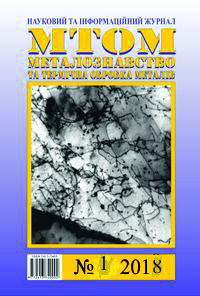Investigation of the structure of ceramic gas-resistant gas-plasma coating by methods of light and stroke electronic microscopy
DOI:
https://doi.org/10.30838/J.PMHTM.2413.240418.43.104Keywords:
ceramic composite material, plasma spraying, , thermal protective coating, combustion chamber, gas turbine engineAbstract
Purpose. The main goal of the research was to establish the essence and sequence of development of the main processes responsible for the formation of the thermal insulation layer, the regularities of the phenomena and the results of their influence on the properties of the ceramic coating. Methodology. The structure of the sprayed ceramic heat-resistant gas-flame coating was studied by metallographic methods and scanning electron microscopy. The particle orientation coefficient was determined by the secant method. Results. The structure of a ceramic heat-resistant gas-plasma coating was studied, it was established that it consists of two types of nanoscale particles: plane lobes 200-950 nm in thickness and dispersed spherical particles with a diameter of up to 800 nm. Numerous voids up to 300 nm thick between the petals and nanospheres impart high thermal insulation properties to the coating. Scientific novelty. The scheme of the formation of layered structures for the spreading of drops of sputtered molten spinel material was proposed for the first time. Practical significance. The established regularities of the phenomena responsible for the formation of the heat-insulating layer allow to influence on the properties of the ceramic coating, and also contribute to the improvement of the technological process of plasma spraying the parts of the combustion chamber of the gas turbine engine.
References
Кудинов В. В. Плазменные покрытия : монография / В. В. Кудинов. − Москва : Наука, 1977. − 135 с.
Демиденко Л. М. Высокоогнеупорные композиционные покрытия : монография / Л. М. Демиденко. − Москва : Металлургия, 1979. − 246 с.
Газотермические покрытия из порошковых материалов : справочник / [Ю. С. Борисов, Ю. А. Харламов, С. Л. Сидоренко, Е. Н. Ардатовская]. − Киев : Наукова думка, 1987. − 176 с.
Хасуй А. Техника напыления : монография / А. Хасуй. − Москва : Машиностроение, 1975. − 211 с.
Большаков В. И. Особенности применения световой и электронной микроскопии при изучении структурообразования покрытий / В. И. Большаков, А. В. Зайцев, Г. Д. Сухомлин, Ф. Ф. Вашкевич // Металознавство та термічна обробка металів. − № 1. − 2007. − С. 7−12.
REFERENCES
Kudynov V.V. Plazmennye pokrytyia [Plasma coatings]. Moscow : Nauka Publ., 1977, 135 p. (in Russian).
Demydenko L.M. Vysokoohneupornye kompozytsyonnye pokrytyia [Highly refractory composite coatings]. Moscow : Metallurgiya Publ., 1979, 246 p. (in Russian).
Borysov Yu.S., Kharlamov Yu.A., Sydorenko S.L. and Ardatovskaya E.N. Hazotermycheskye pokrytyia yz poroshkovykh materyalov: spravochnik [Gas thermal coatings from powder materials: a reference book]. Kyiv : Naukova dumka Publ., 1987, 176 p. (in Russian).
Khasui A. Tekhnyka napylenyia [Sputtering technique]. Moscow : Mashynostroenye Publ., 1975, 211 p. (in Russian).
Bolshakov V.I., Zaitsev A.V., Sukhomlin H.D. and Vashkevich F.F. Osobennosty prymenenyia svetovoi y эlektronnoi mykroskopyy pry yzuchenyy strukturoobrazovanyia pokrytyi [Features of the application of light and electron microscopy in the study of the structure of coatings]. Metaloznavstvo ta termichna obrobka metaliv [Metal Science and Heat Treatment of Metals]. 2007, no. 1, pp. 7−12. (in Russian).
Downloads
Published
Issue
Section
License
Authors that are published in this journal agree to follow the conditions:
Authors reserve the right to the authorship of his work and cede the right to the journal of first publication of this work on conditions of the license under the Creative Commons Attribution License, which allows others to distribute it freely with the obligatory reference to the author of the original work and the first publication of the work in this journal.

